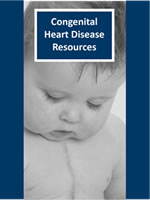Children and Youth with Special Health Needs (CYSHN)
Programs
Contact Info
Pulmonary Atresia and Pulmonary Stenosis
Condition Description
Pulmonary atresia and stenosis are congenital heart defects where the valve that lets blood flow from the right ventricle to the pulmonary artery is either not formed or is narrow. This either blocks blood from getting to the lungs or constricts the amount of blood that is able to be pumped to the lungs. The tricuspid valve between the right atria and right ventricle is also typically abnormal and there is a right to left shunt through an opening between the upper two chambers (atria). Blood flows to the lungs through a vessel called a patent ductus arteriosus. There is no known cause for this abnormality that occurs because of a failure of tissues to properly form in the early weeks of fetal life.
Babies with pulmonary valve atresia and stenosis are usually born at term and appear healthy at birth because the heart is not required to provide oxygen to the baby prior to birth (the placenta serves this function before birth). Shortly after birth the ductus arteriosus closes, which is a life-threatening condition for the baby since there is then no way for blood to travel to the lungs to be refreshed with oxygen. The baby will begin to breathe quickly, have a rapid heartbeat and be bluish-grey in color (called cyanosis) because of low levels of oxygen in the blood in the body
Individuals with congenital heart defects will need to be followed long-term by a cardiologist to be sure that any complications or new conditions are quickly detected and treated. They also typically require antibiotics when they have dental work because the bacteria in the mouth can circulate through the blood and cause infection in the heart structures (endocarditis).
Our program has been tracking pulmonary valve atresia and stenosis among live births in select counties since 2005 and now track all conditions statewide.
- Using data from births statewide between 2016-2020, we found that approximately 14 babies were born with pulmonary valve atresia and stenosis per 10,000 births.
Using this data, we estimate about 88 babies are born with pulmonary valve atresia and stenosis every year in Minnesota.
